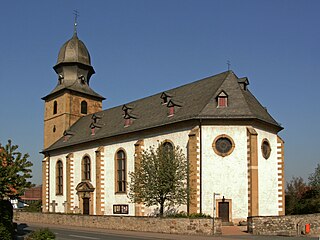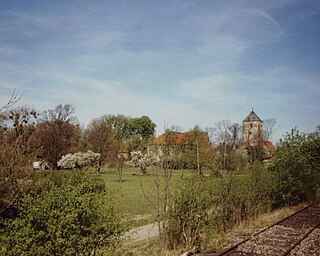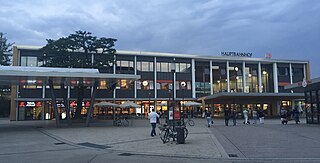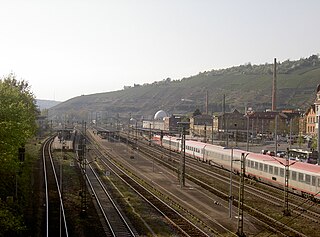
Hildesheim is a city in Lower Saxony, Germany with 101,693 inhabitants. It is in the district of Hildesheim, about 30 km (19 mi) southeast of Hanover on the banks of the Innerste River, a small tributary of the Leine River.

Salzgitter is an independent city in southeast Lower Saxony, Germany, located between Hildesheim and Braunschweig. Together with Wolfsburg and Braunschweig, Salzgitter is one of the seven Oberzentren of Lower Saxony. With 101,079 inhabitants and 223.92 square kilometres (86.46 sq mi), its area is the largest in Lower Saxony and one of the largest in Germany. Salzgitter originated as a conglomeration of several small towns and villages, and is today made up of 31 boroughs, which are relatively compact conurbations with wide stretches of open country between them. The main shopping street of the young city is in the borough of Lebenstedt, and the central business district is in the borough of Salzgitter-Bad. The city is connected to the Mittellandkanal and the Elbe Lateral Canal by a distributary. The nearest metropolises are Braunschweig, about 23 kilometres to the northeast, and Hanover, about 51 km to the northwest. The population of the City of Salzgitter has exceeded 100,000 inhabitants since its foundation in 1942, when it was still called Watenstedt-Salzgitter. Beside Wolfsburg, Leverkusen and Eisenhüttenstadt, Salzgitter is one of the few cities in Germany founded during the 20th century.

Idar-Oberstein is a town in the Birkenfeld district in Rhineland-Palatinate, Germany. As a Große kreisangehörige Stadt, it assumes some of the responsibilities that for smaller municipalities in the district are assumed by the district administration. Today's town of Idar-Oberstein is the product of two rounds of administrative reform, one in 1933 and the other in 1969, which saw many municipalities amalgamated into one. The various Stadtteile have, however, retained their original identities, which, aside from the somewhat more urban character encountered in Idar and Oberstein, tend to hearken back to each centre's history as a rural village. Idar-Oberstein is known as a gemstone town, and also as a garrison town. It is also the largest town in the Hunsrück.

Bad Salzdetfurth (help·info) is a town on the banks of the River Lamme in the district of Hildesheim, in Lower Saxony, Germany.

Heusenstamm is a town of over 18,000 people in the Offenbach district in the Regierungsbezirk of Darmstadt in Hesse, Germany.

Zell (Mosel) is a town in the Cochem-Zell district in Rhineland-Palatinate, Germany. Zell has roughly 4,300 inhabitants and is the seat of the like-named Verbandsgemeinde.

Bad Münster am Stein-Ebernburg is a spa town of about 4,000 inhabitants in the Bad Kreuznach district in Rhineland-Palatinate, Germany. Since 1 July 2014, it is part of the town Bad Kreuznach. It was the seat of the former like-named Verbandsgemeinde, but not part of it. Bad Münster am Stein-Ebernburg was granted town rights on 29 April 1978 and is recognized as a mineral spring spa (Mineralheilbad) and a climatic spa. Today the "Spa" is famous for its clinics specializing in cardiological and orthopaedic rehabilitation. The many graduation towers form the largest open air inhalatorium in Europe.
Bodenburg is a village in Lower Saxony, Germany. It is located about 20 km south of Hildesheim, and about 5 km from Bad Salzdetfurth. The community has a population of 1,814 (2021).

The Hildesheim Forest is a range of hills up to 359 m above sea level (NN) in the district of Hildesheim in the German state of Lower Saxony.

Steuerwald Castle is a Romanesque castle in Hildesheim, a city in Lower Saxony, Germany.

Hildesheim Hauptbahnhof is the main railway station for the city of Hildesheim in Lower Saxony, Germany. The station opened in 1961 and is located on the Lehrte–Nordstemmen, Hildesheim–Brunswick and Hildesheim–Goslar railway. The train services are operated by DB Fernverkehr, Erixx, Metronom and NordWestBahn.

The Lamme Valley Railway is a branch line, that branches off the Hildesheim–Goslar railway in Groß Düngen and continues today via Bad Salzdetfurth to Bodenburg. From there it used to continue via Lamspringe to Bad Gandersheim on the Brunswick–Kreiensen railway.
The Sauberge is a hill range up to 317 m above sea level (NN) in the Innerste Uplands in the district of Hildesheim in eastern Lower Saxony in Germany.

Östrum is a village in the southern part of the town of Bad Salzdetfurth in Lower Saxony, Germany. The L 490 state road runs through the village crossing with the L493. Its immediate neighbours are the villages of Breinum to the west and Bodenburg to the south.
Klein Düngen is a village in the northern part of the town of Bad Salzdetfurth in Lower Saxony, Germany. Klein Düngen is on the river Lamme, a tributary of the River Innerste. The Lamme Valley Railway passes the village, but the nearest railway station is in Groß Düngen, a larger village in the west.
Groß Düngen is a village in the town of Bad Salzdetfurth, in the north German state of Lower Saxony. It lies in the Innerste valley southeast of the county town of Hildesheim on the B 243 federal highway.

Esslingen (Neckar) station is the most important station in the town of Esslingen am Neckar in the German state of Baden-Württemberg and is located 13.2 kilometres (8.2 mi) from Stuttgart Hauptbahnhof on the Fils Valley Railway.

The Hildesheim–Goslar railway is a 53 kilometre long, double-track and non-electrified main line in the northern Harz foothills in the German state of Lower Saxony. It serves mainly to connect with the tourist region in the northern Harz with Hildesheim and Hanover. It is served by the HarzExpress, running between Halle, Halberstadt, Goslar and Hannover Hauptbahnhof. The most important station and junction of the line is Salzgitter-Ringelheim station.

Nordstemmen station is located on the Hanover–Göttingen railway and the Hildesheim–Löhne railway in the town of Nordstemmen in the German state of Lower Saxony. The station building was built by Conrad Wilhelm Hase (1853–1854), but it has not been used by Deutsche Bundesbahn or Deutsche Bahn since 1977. Since 2011, the Hildesheim contractor Dirk Bettels has tried in vain to acquire and rehabilitate the grade II heritage-listed station building with public funds. Construction work begun by Dirk Bettels was discontinued at the end of March 2013 because no contract had been signed by Deutsche Bahn.

At 358.9 m above sea level (NHN) the Griesberg near Bad Salzdetfurth in the Lower Saxon county of Hildesheim is the highest hill in the Hildesheim Forest, a small range of the Innerste Uplands.























